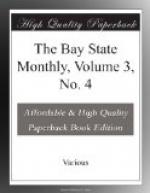Her residence in Newport as a busy and successful literary woman thus formed a distinct period of her life, quite apart from the epoch which preceded it and from the later one which followed. A change soon came. Her health was never very strong, and she was liable to severe attacks of diphtheria, to relieve which she tried the climate of Colorado. She finally took up her residence there, and was married about 1876, to William S. Jackson, a merchant of Colorado Springs. She had always had the greatest love for travel and exploration, and found unbounded field for this in her new life, driving many miles a day over precipitous roads, and thinking little of crossing the continent by rail from the Atlantic to the Pacific. In the course of these journeys she became profoundly interested in the wrongs of the Indians, and for the rest of her life all literary interests and ambitions were utterly subordinated to this. During a winter of hard work at the Astor Library in New York she prepared her “Century of Dishonor” (1881). As one result of this book she was appointed by the United States Government as one of two commissioners (Abbot Kinney being the other) to examine and report upon “the condition and needs of the Mission Indians of California.” Their report, to which Mrs. Jackson’s name is first signed, is dated at Colorado Springs, July 13, 1883, and is a thoroughly business-like document of thirty-five pages. A new edition of “A Century of Dishonor” containing this report is just ready by her publishers, Messrs Roberts Brothers.
As another fruit of this philanthropic interest, she wrote, during another winter in this city, her novel, “Ramona,” a book composed with the greatest rapidity, and printed first in the Christian Union, afterward appearing in a volume in 1884. Its sole object was further to delineate the wrongs of the aborigines. Besides these two books, she wrote, during this later period, some children’s stories, “Nelly’s Silver Mine, a Story of Colorado Life” (1878), and three little volumes of tales about cats. But her life-work, as she viewed it at the end, was in her two books in behalf of the Indians.
* * * * *
HINGHAM.
By Francis H. Lincoln.
[Illustration: THE PUBLIC LIBRARY BUILDING, BURNT IN 1879.]




